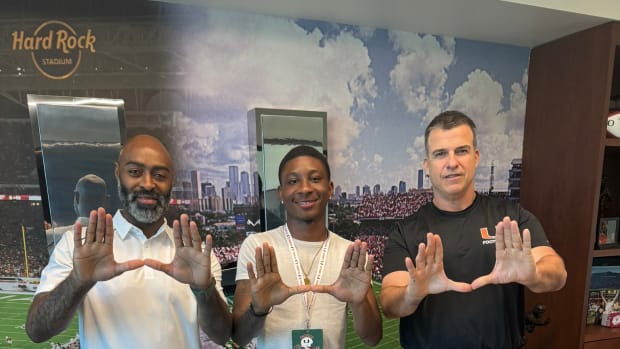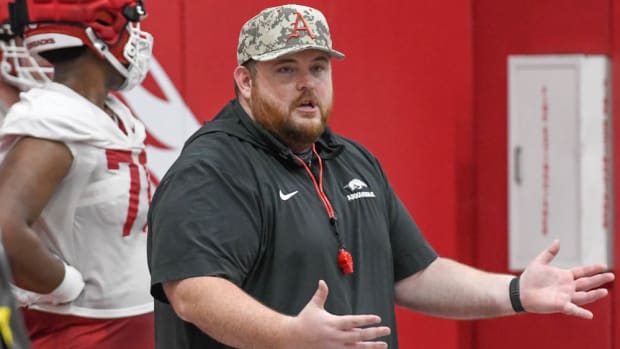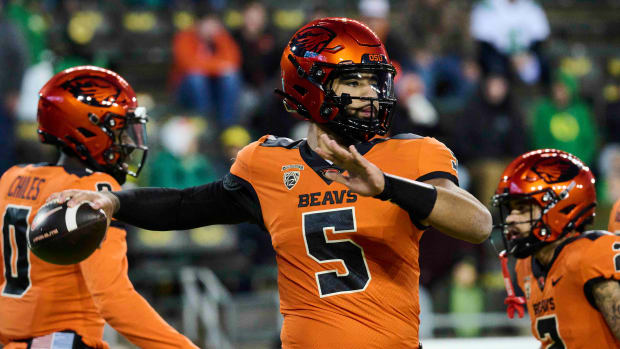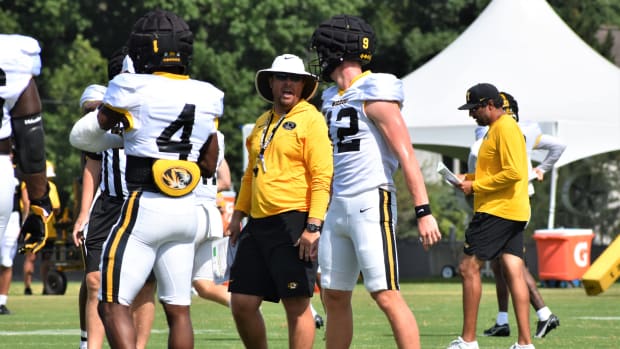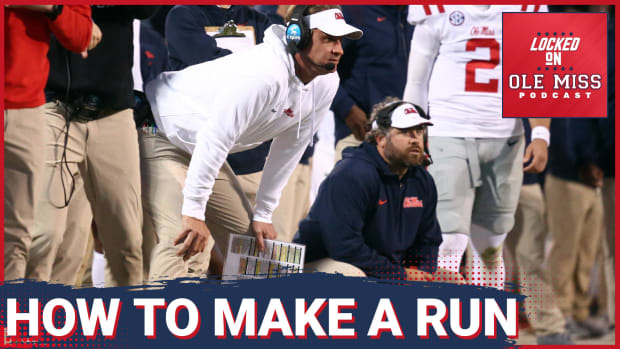
Film Room: What Does Georgia Have to Do Differently This Time vs. Alabama?
Will the Georgia-Alabama sequel be anything like the original? Well, you’d certainly hope not after two largely uncompetitive semifinal games got us back right where we were a month ago: a 41–24 SEC title game boat racing in Bama’s favor. Vegas sees Monday’s game as a tighter affair, with Georgia as a three-point favorite, 3.5 points fewer than the first game. It’s not likely that the Crimson Tide will again be 17 points better than the Bulldogs, but the combined lessons of the OG matchup and both teams’ College Football Playoff romps beg questions about what can be done this time.

Williams scores a touchdown against Georgia in December's SEC title game.
Jason Getz/USA TODAY Sports
Will Bryce Young have to do almost everything again?
It is no secret that Young’s record-breaking, Heisman-securing day powered Bama to the victory. His 421 yards through the air with another 60 on the ground were more than enough. But when you conceptualize how he effectively snatched the game for Alabama it becomes all the more impressive. The Tide shattered the belief that the Dawgs' defense was impregnable while scoring 31 of their 34 offensive points over the course of five straight possessions. It was largely thanks to Young putting the offense on his shoulders. But whether the performance is repeatable against this defense will be hashed out Monday night.
On Bama’s second scoring drive, Young’s incredible lateral comes from his backbreaking ability to scramble. As the Dawgs get out of rush lanes coming too far up the field, Young punishes them with a pitch after a broken tackle.
Georgia had better be ready for this type of play, as it adds a layer of complexity to Young’s scrambles.
Back in Atlanta, two plays after the Dawgs learned that harmful lesson, they opted to not fly as far upfield and instead keep Young penned in the pocket. The time it afforded him allowed him to point out a target for a touchdown.
On the next drive, instead of being sacked, Young completed the below third-down pass to tight end Jahleel Billingsley while falling down. Had Bama punted to Georgia instead of driving 12 plays across more than five minutes and kicking a field goal, the Dawgs would have had an extra possession—and one that likely would have started in decent field position. Instead, Alabama scored for the third time.
Scoring drive No. 4 doesn’t happen if Young isn’t able, somehow, to recover his own fumble underneath three Georgia defenders. Perhaps it could have even been a sack if defensive tackle Jordan Davis hadn’t fallen down while spying Young.
The quarterback scrambled in for a TD a couple of plays later because although UGA’s coverage took away the wheel route he was looking for, the spying Jalen Carter drifted ever-so-slightly toward where Young was looking to throw. When Young tucked it to run, the angle was impossible for Carter to cut off and Young ran to pay dirt.
Georgia knows the task Monday will be actually getting Young on the ground this time.
“We say all the time here the best rush is the best coverage, and we've got to get to the quarterback,” linebacker Nolan Smith said in the lead-up to the national championship. “There's nothing else about it. Last game, we did not do that. And I know a lot of people felt hurt after that one. I hold myself and my room accountable and also the D-line. It's our job as pass rushers to get after the quarterback and we didn't do that. The difference between this game and that game is we just have to do it. We have to find a way. I believe in our coaches. I trust in the plan that we are talking over still to be able to do that.”
Edge pressure is one way to get at Young, but interior pressure against any quarterback, particularly one who is on the shorter side of the spectrum (6' 0", as the Bama QB is) is particularly troublesome. And it’s not as if Georgia can’t do it. It’s that by the time it started really getting stops in the SEC title game, the Dawgs were down two scores.
Young did not play all that well his last time out against Cincinnati, which to be fair did not feature a game script or an offensive game plan that demanded much of Young. One of his five interceptions this season did come in that game, with pressure coming right down the middle picking on the inexperience of center Seth McLaughlin, who was making his second career start.
Can Georgia handle the bunches?
The above interception features a couple of themes of Alabama’s offense this season.
- The pass is intended for Jameson Williams.
- The pass protection doesn’t exactly hold up.
- The receivers are lined up in a bunch set.
Young leads the country in dropbacks that feature bunches, per Sports Info Solutions. Georgia knows the way the Tide can sting defenses out of these formations. This is how the Tide scored on the first of those five straight possessions.
Leading to the confusion of how to handle Williams (or any Bama WR) is how they release out of the bunch. The Williams TD shows that all three receivers do not simply take off down the field at the snap every time. Sifting through who is going where and when incorrectly can lead to coverage busts, like the one that created one of Williams’s SEC title game scores.
And Bama will play with who is in the bunch (often adding a tight end to run bubble screens) in addition to what it does out of the bunch and how it gets into the formation at all (using motion to create and hide its intention until right before the snap). This may seem like a normal crossing route by the Tide’s Slade Bolden, but the slight delay postsnap can help WRs get lost in the coverage.
When all else fails in the passing game for the Tide, simply asking Williams to win down the field is also a fine plan off attack—something Georgia also knows well. But vertical routes demand protection to hold up, especially ones with double moves. When they work, they’re a thing of beauty for the Bama offense, and this was score No. 5 back in December.
The injury to Williams’s battery mate John Metchie III again looms large for the Alabama passing game, as Metchie was the primary target of Young before getting injured in the second half of the SEC title game. His absence wasn’t felt tremendously, as Ja'Corey Brooks scored on a deep shot against Cincinnati as Bama picked on a slot corner and used Williams as a decoy, and Alabama didn’t throw the ball too much. It will need someone to step up against opposite Williams in order to win Monday. Nobody’s worried about Georgia’s front seven, but the back end was exposed the first time against the Tide.
Can either of these teams run the ball, or are there better ways to attack quickly?
Perhaps the better question is: Do they even plan to? The edict was clear from the Tide in the semifinal game against Cincinnati: we’ll run it until you stop it. The Bearcats weren’t able to, and Bama had a healthy lead in the second half, anyway. Brian Robinson Jr. had a breakout performance against a Cincy team that could not bring him down on first contact, producing a bruising 7.8 yards per carry on 26 totes. Georgia is a different deal where tackling is concerned.
Bama ran only 22 designed runs in the SEC title game despite the fact that it spent the entire second half with a lead. Young is not much for a designed QB running game, and both he and Georgia QB Stetson Bennett get the job done via scrambling.
When Georgia looks to run the ball, the chief concern involves handling all-world defender Will Anderson Jr. Because even if you get a body on him, he can still make plays like this incredible absorption of contact to shoestring tackle what would otherwise have been an explosive run.
The Dawgs just faced a similarly disruptive edge in Michigan’s Aidan Hutchinson, opting to go away from him on multiple rushing attempts or around him by isolating and reading him in space.
Will Stetson Bennett doom or deify these Dawgs?
Georgia had a clear plan of attack against Michigan, and that was to get the ball on the perimeter and attack Michigan laterally. Some of its quick game carries over, including the group cut blocking strategy it uses as a changeup to traditional drop-back protections.
In the flats, Georgia’s running backs will be big to help this passing game by gaining yards after the catch on quick-hitting passes. James Cook also showed an ability to get vertical in the passing game as well.
Despite all of the criticism about what Bennett can’t do, what he can do has gotten Georgia plenty far this season. That includes an impressive ability to hit throws like this to his big targets in the middle of the field, doing well to get the ball over linebackers and in front of safeties.
He often finds tight end Brock Bowers, a target even Nick Saban can’t help but gush about.
“I think this guy is one of the premier players in college football. I know he's just a freshman. But this guy's got great size,” Saban said. “He's a good blocker. He's physical. He's tough. And he's got wide receiver skills in every way, shape or form, which makes it difficult being a bigger guy for bigger guys to cover him and it makes it also difficult for smaller guys to cover him.”
And although he isn’t used as much in the passing game, fellow tight end Darnell Washington also poses a threat downfield. Georgia will line them up next to each other in two-tight end sets and run them vertically up the field. Pick your poison.
Bowers, along with George Pickens, add the vertical element to Georgia’s passing game.
But Bennett’s deep-ball delivery will have to be the good version he has shown.
Against Alabama in the SEC title game, he showed some not-so-good, too, on this underthrown ball bailed out by pass interference.
But on deep throws to Pickens in the SEC championship as well as against the Wolverines, Bennett showed how his deep-ball accuracy has improved over the course of this season.
What’s more of a concern isn’t just Bennett’s deep-ball execution but also his process in the passing game. Bama barely blitzed Bennett at all in the first go-around, bringing five or more pass rushers on only five snaps of his 53 drop-backs.
But the illusion of pressure can bait quarterbacks into bad decisions, as Bennett showed in the first Alabama game throwing into the face of a late rushing safety ...
And this one deep downfield does find a safety who breaks late on the pass.
Game script may end up being the thing that takes the pressure off Bennett. If Georgia’s defense can keep this close and he isn’t forced to press the issue with a big deficit, he’s shown he can be an adept distributor that can surprise you with downfield pop. Alabama is the hump Georgia has to get over, and the most satisfying way to end a 40-year title drought would be to beat the Tide.
More College Football Coverage:
• Is the SEC's CFP Dominance Bad for the Sport?
• Can Playoff Expansion Get Over Its Hurdles?
• Used to the Coaching Carousel? Meet the QB Shuffle
